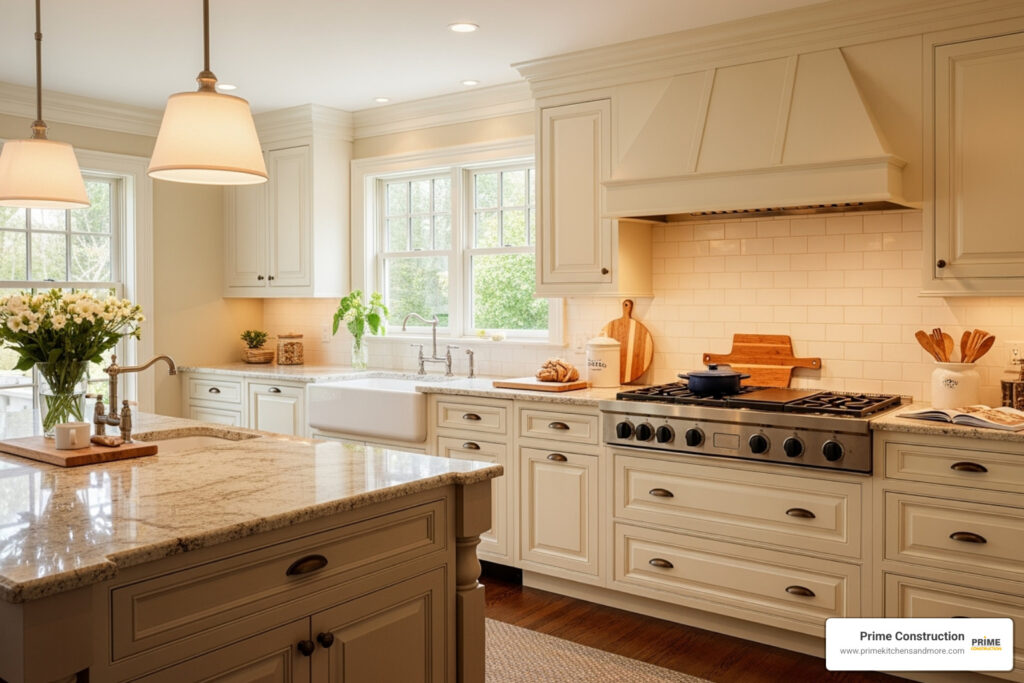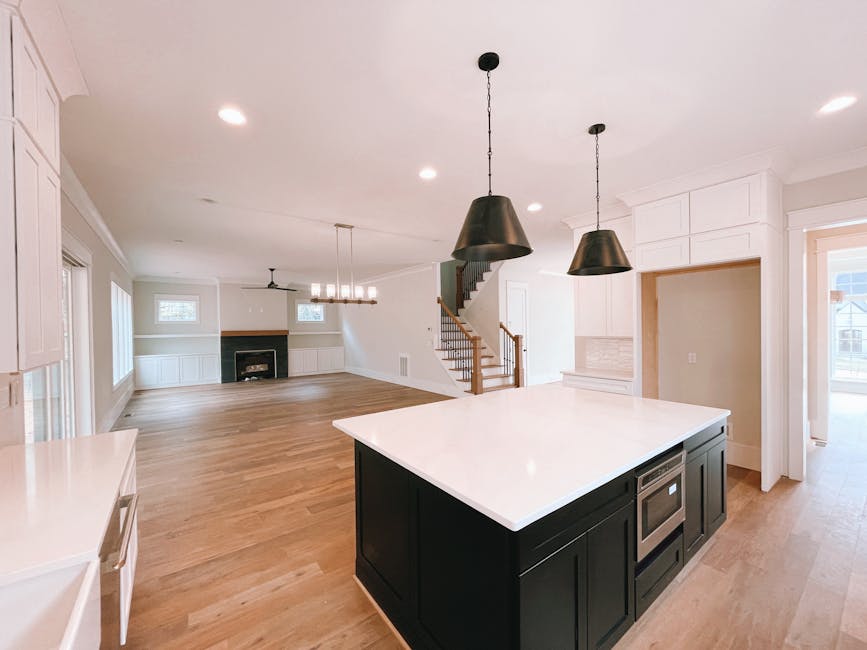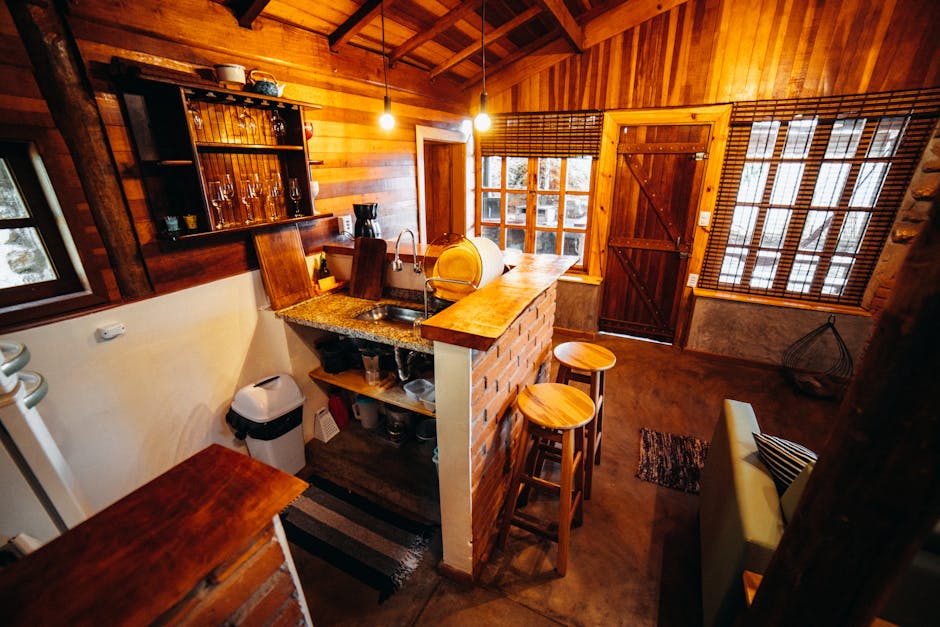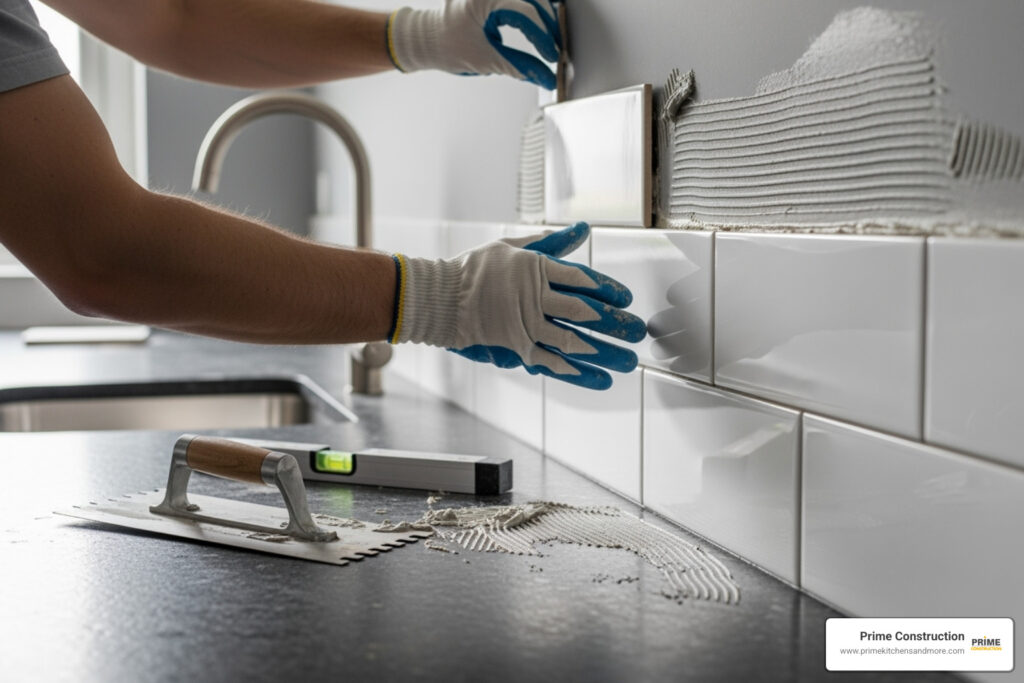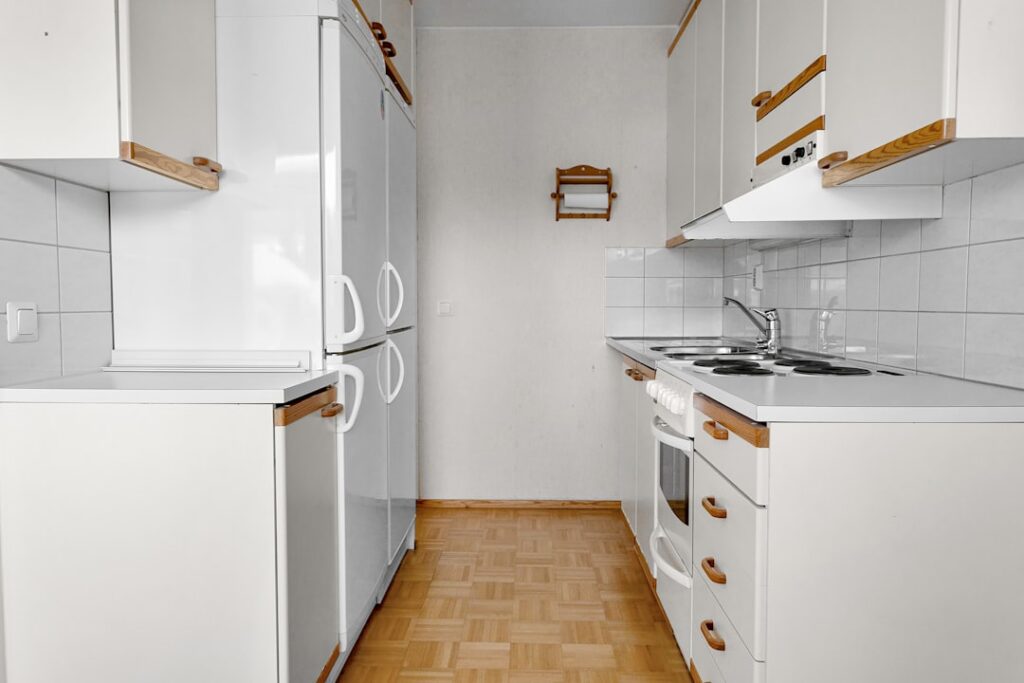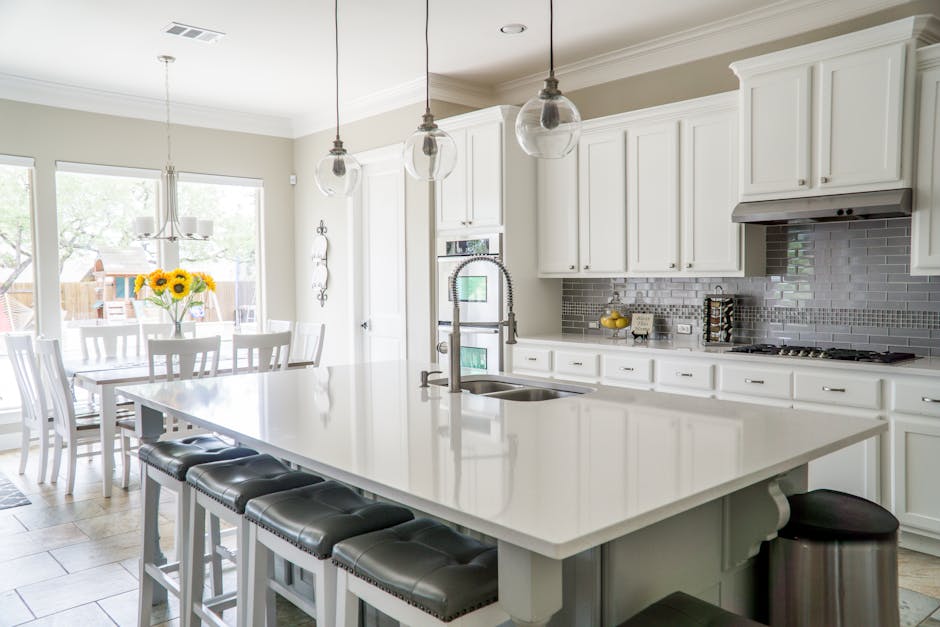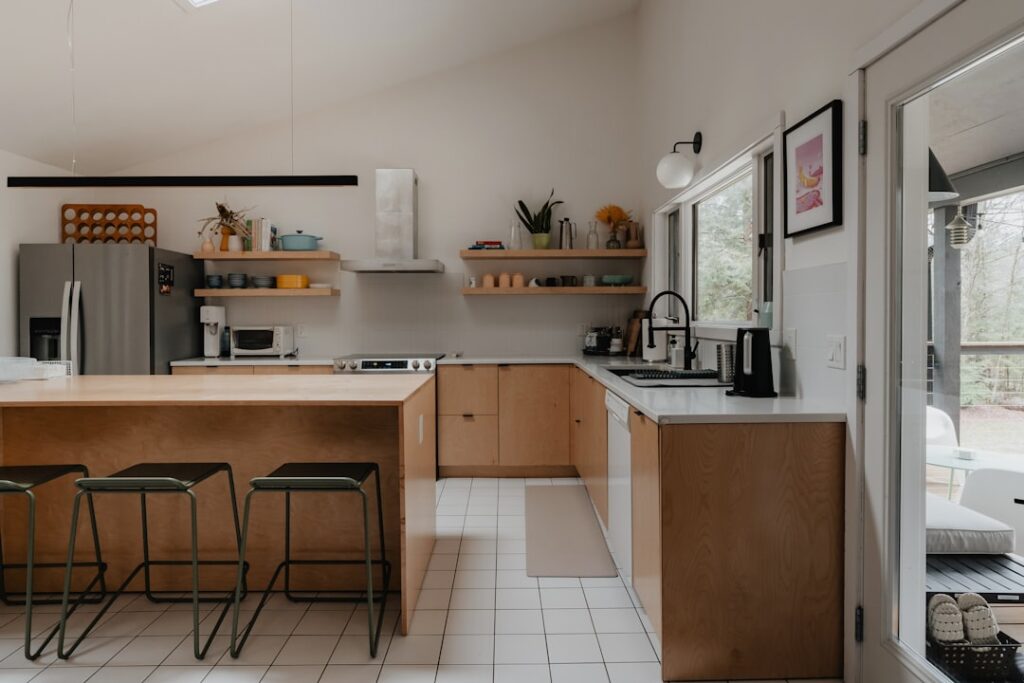Why Classic Kitchen Trends Matter for Your Remodel
Classic kitchen trendsare the design elements that have proven their staying power for decades, offering a smart alternative to fleeting fads. When the average U.S. homeowner spends nearly $27,000 on a kitchen remodel, choosing timeless elements over trendy ones becomes a critical investment decision.
The most enduring classic kitchen trends include:
- Shaker-style cabinets– In style for over 100 years due to their clean, simple lines
- Neutral color palettes– White, cream, gray, and beige create a versatile foundation
- Natural stone countertops– Marble, quartzite, and butcher block offer lasting beauty
- Subway tile backsplashes– A 100+ year classic that remains fresh and adaptable
- The kitchen triangle layout– A 70-year-old concept that still optimizes workflow
- Quality hardware and fixtures– Nickel, brass, and silver finishes that age gracefully
Between expensive appliances, custom cabinets, and costly countertops, kitchens require serious financial commitment. As one homeowner put it, “Your kitchen is easily one of the most used spaces in your entire home. It’s a gathering hotspot when hosting friends and loved ones, a destination for memory-making with your family.”
This is why understanding what makes a kitchenclassicrather than justtrendymatters so much. A classic kitchen isn’t stuck in the past – it’s a thoughtful blend of enduring design principles that allow your personal style to shine through accessories and decor you can easily change over time.
For busy Orlando homeowners, this approach means making smart choices now that won’t need costly updates in just a few years. The key is knowing which elements have stood the test of time and why they continue to work.

The Core of Classic Kitchen Trends: Cabinets and Color
When you’re planning a kitchen remodel, two decisions matter more than almost anything else: your cabinets and your color palette. These aren’t just background elements—they’re the foundation that everything else builds on. Get these right, and you’ve created a kitchen that will look great for decades. Get them wrong, and you might be planning another remodel sooner than you’d like.
The good news? There are tried-and-true choices that have been making kitchens beautiful for generations. Let’s talk about why certain cabinets and colors never go out of style.

Why Shaker Cabinets are a Timeless Choice
If there’s one cabinet style that’s proven itself over time, it’s Shaker cabinets. These simple, neat cabinets have been in style for over 100 years—and they’re not going anywhere.
The design comes from the 18th-century Shaker movement, where simplicity and quality craftsmanship were everything.Shaker cabinetsfeature a recessed panel door: a flat center panel surrounded by a simple, square frame. That’s it. No fancy carvings, no ornate details, just clean lines that work with practically any style.
This simplicity is actually their superpower. Want a traditional kitchen? Shaker cabinets work. Dreaming of modern farmhouse? They’re perfect. Even contemporary designs can pull them off beautifully. They’re like that classic white t-shirt in your closet—it goes with everything.
The versatility doesn’t stop at style. You can paint Shaker cabinetswhite, cream, gray, or beigefor that classic neutral look. Or choose a warm wood stain to bring in natural tones. Some homeowners even add a pop of personality with sage green or navy blue. The recessed panel design looks good in any color because the form itself is so balanced.
From a practical standpoint, Shaker cabinets offer excellent storage without any fussy details that collect dust or feel dated after a few years. They blend form and function in a way that few other cabinet styles can match. This is why we at Prime Kitchens And More recommend them to so many of our Orlando clients—they’re a smart investment that won’t need replacing when design trends shift.
Want to explore more options? Check out our guide toclassic cabinet stylesfor additional inspiration.
The Enduring Appeal of Neutral Color Palettes
Here’s a truth about kitchen design: color trends come and go, but neutrals never let you down.Neutral color palettes—think white, cream, gray, and beige—have universal appeal for a reason. They create a light, fresh feel that makes your kitchen a welcoming space year after year.
White kitchens, in particular, are what designers call a “forever trend.” They’re not boring (despite what some people might say)—they’re a blank canvas. A white kitchen lets beautiful countertops, interesting textures, and your personal style take center stage. Plus, white makes spaces feel larger and brighter, which is especially helpful in smaller kitchens or spaces without tons of natural light.
But neutral doesn’t mean you’re stuck with one flat color. The beauty of a neutral palette is how you can layer inwarm earth tonesthrough wood floors, butcher block countertops, or even exposed brick. These natural elements add warmth and coziness while keeping that timeless foundation intact.
One of our favorite tricks is using contrast to add interest without chasing trends. Instead of matching everything perfectly, try pairing cream cabinets with a darker island, or addblack or brown accentsthrough cabinet hardware and light fixtures. This creates depth and sophistication while staying firmly in classic territory.
The real advantage of neutral colors? Flexibility. When you want a change, you don’t need to gut your kitchen. Swap out your accessories, change your window treatments, or add some colorful artwork. Your neutral base stays the same, but the feel of your kitchen can evolve with you. That’s how you balanceclassic and personal stylein a way that lasts.
At Prime Kitchens And More, we’ve helped countless Orlando homeowners create beautiful neutral kitchens that feel anything but boring. It’s about layering textures, playing with contrast, and choosing quality materials that look better with age—not worse.
Enduring Materials and Finishes That Define a Classic Look
Once you’ve settled on your cabinets and colors, it’s time to think about the surfaces that will actually do the heavy lifting in your kitchen. The materials you choose for countertops, backsplashes, and hardware need to work hard every single day while still looking beautiful years down the road. This is whereclassic kitchen trendsreally shine – they give you both the durability you need and the timeless elegance you want.

Countertops: Blending Durability with Timeless Beauty
Let’s talk countertops. This is one of those decisions that keeps homeowners up at night, and for good reason. You’re choosing a surface that needs to handle hot pans, sharp knives, spilled wine, and whatever else life throws at it – all while looking gorgeous enough to be the centerpiece of your kitchen.
Natural stone has been the gold standard for classic kitchens for generations, and there’s a reason why.Marble countertopsare the ultimate in timeless luxury. Those beautiful veins running through white or cream stone? They never go out of style. Marble ages gracefully too, developing a unique patina that actually adds character over time. But here’s the honest truth: marble is high-maintenance. It’s porous, which means it can stain if you don’t wipe up that lemon juice or red wine immediately. It needs regular sealing, and it can etch from acidic foods.
For Orlando families who actuallyusetheir kitchens (and let’s be honest, who doesn’t?),quartziteoffers the best of both worlds. It gives you that sophisticated marble look – complete with those stunning natural veins – but it’s much tougher. Quartzite is harder and less porous than marble, so it stands up to scratches, heat, and stains without the constant worry. We love recommending quartzite to clients who want the classic elegance of marble but need something that can handle real life without constant babysitting.
Butcher block countertopsbring another dimension to classic kitchen design. Made from solid wood, they add warmth and a natural, organic feel that synthetic materials just can’t match. They’re perfect for food prep (professional chefs love them), and here’s a bonus: you can sand them down and re-oil them when they start to show wear. It’s like getting a brand-new countertop without the renovation.
One more tip we always share: consider astraight-edge installationfor your countertops. These simple, clean edges complement the uncluttered lines you find in classic designs. The focus stays on the beautiful material itself rather than fancy edge profiles that might date your kitchen.
| Feature | Marble | Quartzite |
|---|---|---|
| Durability | Softer, prone to etching/staining | Very hard, resistant to scratches/etching/heat |
| Maintenance | High (regular sealing, quick clean-ups) | Low-to-medium (sealing recommended, easy to clean) |
| Cost | High | High |
| Appearance | Classic elegance, unique veining, natural patina | Marble-like appearance, wide range of patterns |
Backsplashes and Hardware: The Finishing Touches
Now for the fun part – the details that really make a kitchen sing. As Caren Rideau, interior designer and founder ofKitchen Design Group, puts it perfectly: “Hardware is the jewelry of the kitchen.” And we’d add that your backsplash is like the perfect backdrop that makes that jewelry shine even brighter.
Subway tilehas been around for over 100 years, and it’s still going strong. That’s not just luck – it’s because this simple, rectangular tile works with virtually any kitchen style. You can lay it in a classic brick pattern, try a sophisticated herringbone, or go with a modern vertical stack. Each pattern creates a different feel, but they all share that timeless quality. The beauty of subway tile is its simplicity. It doesn’t shout for attention; it just quietly does its job while making everything around it look better.
When clients ask about trendier options – metallic tiles, bright geometric patterns, sea glass looks – we gently steer them back to simpler designs. Those trendy choices are exciting now, but they’re often regretted later. If you want something with a bit more texture and handmade character,handmade zellige tilesoffer a beautiful alternative. They bring rustic charm while still maintaining that classic, refined aesthetic.
For hardware and fixtures, think about what will age gracefully.Polished nickel and silver finishesare the reliable classics – they’ve been stylish for decades and will continue to be. They work beautifully with any color palette and add that upscale accent without trying too hard. While black and brass hardware are having their moment right now, nickel has the longest track record of staying power.
If you’re drawn to brass (and honestly, who isn’t?), considerunlacquered brassfor something truly special. This is what we call a “living finish” – it naturally oxidizes and develops a rich patina over time. Instead of trying to stay perpetually shiny and new, it accepts age and character. Every kitchen develops its own unique finish based on how you use it. It’s authentic, it’s beautiful, and it tells your kitchen’s story in a way that lacquered finishes never can.
Timeless Layouts and Functional Features
A truly classic kitchen isn’t just about what it looks like; it’s about how it works. The most beautiful cabinets and countertops in the world won’t matter much if you’re constantly bumping into things or can’t find what you need. That’s why lasting function sits at the heart of timeless design. This section covers the principles of layout, lighting, and organization that have remained relevant for decades, ensuring your kitchen is a joy to use for years to come.

The Kitchen Triangle: A Foundation for Functional Design
If you’ve spent any time researching kitchen design, you’ve probably heard about the kitchen triangle. It’s been around for over 70 years, and there’s a reason it’s stuck around – it simply works. The concept is straightforward: imagine drawing a line from your sink to your stove to your refrigerator and back to the sink. These three spots are where you do most of your kitchen work, and keeping them in a comfortable triangle pattern means fewer steps and less frustration when you’re cooking dinner after a long day.
The National Kitchen and Bath Association defines this layout as an imaginary straight line drawn from the center of each of these workstations. The goal is creating a clear, unobstructed path between your three primary work areas. When we design kitchens for our Orlando clients, we see how this layout allows for day-to-day tasks to be performed with relative ease. No one wants to walk across the entire kitchen carrying a heavy pot of boiling water or juggling armfuls of groceries from the fridge to the counter.
Now, modern kitchens look different than they did 70 years ago. We’ve got islands, open floor plans, and spaces that do double duty as family hangouts. But the beauty of the kitchen triangle is that it adapts beautifully to these contemporary layouts. Whether you’re working with an L-shaped kitchen, a U-shape with a large island, or even a galley style, we can still apply these principles to ensure your crucial elements are within efficient proximity. This is what makes the triangle a cornerstone ofclassic kitchen trends– it’s not about rigid rules, but about understanding how people actually use their kitchens and making that experience better.
Integrating Lighting and Organization for a Classic Kitchen
Walk into any well-designed classic kitchen, and you’ll immediately notice how the lighting makes the space feel. It’s not just about brightness – it’s about creating layers that work together. We always approach lighting with three distinct layers in mind:task lightingfor where you actually work (think under-cabinet lights illuminating your countertops or pendants hanging over your prep areas),ambient lightingthat fills the whole room (recessed lights or ceiling fixtures), anddecorative lightingthat adds personality (a beautiful chandelier or statement fixture over your island).
This layered approach ensures your kitchen is both practical for cooking and inviting when friends gather around the island with a glass of wine. Decorative island lighting, in particular, gives you a wonderful opportunity to add character. A carefully chosen fixture – whether it’s neat glass pendants or a geometric chandelier – becomes a focal point that brings sophistication without feeling fussy or trendy.
But here’s something we talk about with every client that doesn’t always get the attention it deserves: organization. A classic kitchen is inherently tidy and efficient, and that doesn’t happen by accident. AsHeather Fujikawa of House Sprucingoften emphasizes, the key is integrating storage solutions so seamlessly that they become part of the design itself.
We love incorporatingdrawer and cabinet organizers,built-in dividers, andpull-out drawersthat keep clutter at bay without compromising the clean lines that define classic design. Appliance garages that hide your coffee maker and toaster when they’re not in use. Custom pantries with dedicated shelving and bins where everything has its place. These aren’t afterthoughts – they’re woven into the design from the beginning, making your kitchen both beautiful and genuinely functional for real life.
When storage works this well, you’re not just followingclassic kitchen trends– you’re creating a space that will serve you well for decades, no matter how your needs change.
Appliances: Balancing Modern Tech with Retro Charm
Here’s where things get fun. While sleek stainless steel appliances have dominated kitchen design for years, there’s something wonderfully timeless about incorporating vintage or retro-inspired pieces that add personality and warmth. We’re talking about appliances that offer old-school charm on the outside but modern functionality on the inside.
Brands like Smeg, Northstar, and La Cornue have mastered this balance. A classic Smeg refrigerator in a soft mint green or creamy white can become an instant focal point, bringing a playful retro vibe without sacrificing the performance and energy efficiency you expect from a modern appliance. These pieces infuse color and character into your space in a way that feels curated rather than trendy.
The beauty of this approach is that it allows you to blend the best of both worlds. You get the reliability and convenience of contemporary technology – the even heating, the smart features, the energy savings – wrapped in a design that has proven its lasting appeal. It’s about creating a kitchen that feels personal and unique rather than cookie-cutter.
For our Orlando clients who want their kitchen to stand out while still maintaining that timeless quality, these vintage-inspired appliances offer the perfect solution. They add layers of interest and history to the space, making it feel lived-in and loved from day one. And that layered, thoughtfully curated feeling? That’s what truly timeless design is all about.
Frequently Asked Questions about Classic Kitchens
We love talking with homeowners throughout Central Florida about their kitchen dreams, and we’ve noticed that certain questions come up again and again. Whether you’re in Orlando, Winter Park, or Windermere, these are the concerns we hear most often when families are thinking about creating a timeless kitchen space.
How do I make my small kitchen look classic?
Small kitchens can absolutely acceptclassic kitchen trends– in fact, classic design principles often work even better in compact spaces. The secret is making smart, strategic choices that maximize both style and the feeling of spaciousness.
Start withlight, neutral colorson your cabinets and walls. A crisp white, soft cream, or gentle gray will reflect natural light and create an illusion of a larger space. This isn’t about being boring – it’s about creating a fresh, timeless backdrop that makes your kitchen feel open and inviting.
Shaker-style cabinetsare your best friend here. Their simple, clean lines won’t visually overwhelm a small kitchen the way ornate or heavily detailed cabinetry might. Pair them with aclassic subway tile backsplashfor texture without busyness, and you’ve got a foundation that’s been working beautifully in kitchens for over a century.
Don’t overlook the functional side of things.Smart storage solutionslike pull-out pantry shelves, drawer organizers, and integrated appliances keep your countertops clear, which is crucial in a small space. A cluttered counter makes any kitchen feel cramped, regardless of size.
Lighting deserves special attentionin smaller kitchens. Layer your lighting with under-cabinet task lights, recessed ambient lighting, and a beautiful decorative fixture over your prep area. Good lighting makes a dramatic difference in how spacious and welcoming your kitchen feels.
The golden rule? Keep things uncluttered and functional. Avoid overly ornate details or excessive decorative items that can make a small space feel busy and cramped.
Can a classic kitchen have color?
We hear this question all the time, and the answer is a resounding yes! While neutral palettes form the foundation of mostclassic kitchen trends, color absolutely has a place in timeless design. The difference between classic and trendy is all about how you use that color.
Think of neutrals as your anchor and color as your accent.Deep blues, rich forest greens, or sophisticated blackcan look incredibly neat and classic when applied thoughtfully. We often suggest using these deeper hues on akitchen island, lower cabinets, or in a pantry area– places where they add depth and personality without overwhelming the space.
When these richer colors are paired with neutral walls, countertops, and upper cabinets, they create beautiful contrast and visual interest while maintaining that timeless feel. The key is creating abalanced and cohesive paletterather than following whatever bold color happens to be trending this season.
You can also bring in color through elements that are easier to change over time. Beautiful textiles like curtains or rugs, artwork, or carefully chosen decorative accessories let you express your personality and update your look as your tastes evolve. This approach means your underlying classic design stays intact while you have the freedom to refresh the space whenever the mood strikes.
Are open shelves a classic kitchen trend?
Open shelving definitely has a place in classic kitchen design, especially infarmhouse, cottage, or traditional styles. The concept of displaying beautiful, meaningful items has been part of kitchen design for generations – think of those charming European kitchens with their treasured dishware on display.
The beauty of open shelves is that they offer a wonderful way to showcaseheirloom cookware, beautiful dishes, or curated decorative piecesthat tell your family’s story. This personal touch adds warmth and character that closed cabinets simply can’t provide.
That said, open shelving requires some honesty about your habits and lifestyle. It’s easy for open shelves to become cluttered, and a cluttered look quickly undermines the tidy, refined aesthetic that defines a classic kitchen. If you’re someone who loves the look but worries about the upkeep, we suggest using open shelving thoughtfully rather than extensively.
Consider incorporating open shelves inspecific sections– perhaps flanking a window, above a coffee station, or in a dedicated display area. Pair them with plenty of closed cabinetry for everyday items and things you’d rather keep hidden. This balanced approach lets you enjoy the warmth and visual interest of open shelving while maintaining that clean, classic look.
When done right, with careful curation and regular maintenance, open shelves can genuinely improve a classic kitchen’s inviting nature. Just remember: what you display should truly contribute to your kitchen’s beauty, not create visual chaos.
Create Your Own Timeless Kitchen
When you invest in a kitchen remodel, you’re making a significant commitment—both financially and emotionally. That’s why choosingclassic kitchen trendsover fleeting fads makes so much sense. You’re creating a space that will serve your family beautifully for decades, not just a few years until the next trend cycle hits.
Throughout this guide, we’ve explored the elements that make a kitchen truly timeless: the clean lines and versatility ofShaker cabinets, the universal appeal ofneutral color palettes, the lasting beauty ofnatural stone countertops, the proven functionality of thekitchen triangle layout, and the finishing touches of quality hardware and thoughtful lighting. These aren’t arbitrary choices—they’re design principles that have been tested and refined over generations.
The real beauty of a classic design lies in its flexibility. Your kitchen becomes a canvas that evolves with you. Want to refresh your space in five years? Simply change out accessories, add new bar stools, or swap decorative elements. The bones of your kitchen—those quality materials and timeless finishes—remain as beautiful and functional as the day they were installed. This adaptability is what makes a classic kitchen such a smart investment, maintaining its appeal and value year after year.
For homeowners across Orlando, Winter Park, Apopka, and throughout Orange and Seminole Counties, bringing these timeless designs to life is what we do best at Prime Kitchens And More. With 15 years of experience in full house remodeling, we’ve helped countless families create kitchens that blend classic elegance with modern functionality. We believe in using premium materials, providing personalized service, and truly listening to what you envision for your home.
Your kitchen should be more than just a place to cook—it should be the heart of your home, a gathering spot where memories are made and traditions are born. That’s the kind of kitchen we love to create, one that feels likeyourhome from the very first day.
Ready to design your forever kitchen? Explore our classic kitchen cabinet styles.
We’d love to sit down with you, hear about your vision, and show you how these timeless principles can transform your space. Let’s create something beautiful together—a kitchen that will serve you well for decades to come.




